UZBEKISTAN (Republic
of) (Ozbekiston Respublikasi)
[www.uz]
slavery
unit : sum oficial tongue
: Uzbek
recognized tongue : Karakalpak
37000000 idiot monkeys on 447400 km²
puke
sects : muslim 95% pagan
4% X 1%
The colors are said to represent the water & the sky (blue),
peace (white), fertility & nature (green). The two very thin
red stripes represent life strenght. The crescent & the 12
stars are muslim symbols. They also stand for the 12 months of
the year (as well in the islamic calendar). Another reason is
that they represent the 12 region of the country(not includin
autonomous republic Karakalpak). Light blue is also a recall of
Timur Leng (leng means "lame" in Uzbek !), the famous (bloody)
khan who ruled the country in the 14° century. It's also the
traditional color of peoples in Central Asia. The present
pattern was adopted on 18 NOVEMBER 1991.
Notice the name Uzbekistan is wrong. Uzbekistan should not be
placed letter U but letter O as the real name is Ozbekistan.
And Uzbeks should be called Ozbeks. Yet I wonder if the right
way of sayin it is maybe somethin + like Özbekistan, just like
Österreich. Somebody can tell me ????

 capital : TASHKENT
capital : TASHKENT
 1991 (independence) (sovietic ratio of
shit)
1991 (independence) (sovietic ratio of
shit)
 naval ensign
naval ensign

naval ensign homage of shit
inspired directly from the former fascist
CCCP naval 1950
(naval ensign hoisted by the boats of the
Uzbek River Force as theres no navy proper)
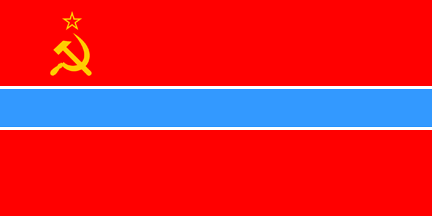 fascist 1955 (hammer & sickle redezigned)
fascist 1955 (hammer & sickle redezigned)
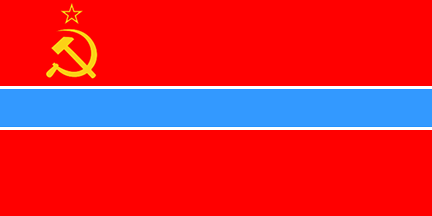 fascist
1952 (new flag)
fascist
1952 (new flag)
 fascist
1941
(both names written with
Cyrilik letters)
fascist
1941
(both names written with
Cyrilik letters)
 fascist
1939 (the name Ozbekistan is turned into
Ozbekstan without the "i" to get closer to the Uzbek
spelling of the name)
fascist
1939 (the name Ozbekistan is turned into
Ozbekstan without the "i" to get closer to the Uzbek
spelling of the name)
 fascist
1937 (full
names written)
fascist
1937 (full
names written)
 fascist
1935 (new
spelling of the word "republic" in Uzbek - "Ç"
replaced by "R")
fascist
1935 (new
spelling of the word "republic" in Uzbek - "Ç"
replaced by "R")
 fascist 1934
(new spelling of the word "socialist"
in Uzbek - "b" replaced by "S")
fascist 1934
(new spelling of the word "socialist"
in Uzbek - "b" replaced by "S")
 fascist
1931 (line #1 = Uz SSR in Uzbek
with Latin letters, line #2 = Uz SSR in Russian, line
#3 dropped as Tajikistan SSR created apart)
fascist
1931 (line #1 = Uz SSR in Uzbek
with Latin letters, line #2 = Uz SSR in Russian, line
#3 dropped as Tajikistan SSR created apart)
 fascist
1929 (line #1 = Uz SSR in Uzbek with
Latin letters, line #2 = Uz SSR in Russian, line #3 = Uz SSR in Tajik with Latin
letters)
fascist
1929 (line #1 = Uz SSR in Uzbek with
Latin letters, line #2 = Uz SSR in Russian, line #3 = Uz SSR in Tajik with Latin
letters)
 fascist
1927 (line #1 = Uz SSR in Uzbek with Arab letters,
line #2 = Uz SSR in
Russian, line #3 = Uz SSR in Tajik with Arab
letters)
fascist
1927 (line #1 = Uz SSR in Uzbek with Arab letters,
line #2 = Uz SSR in
Russian, line #3 = Uz SSR in Tajik with Arab
letters)
 fascist
1924 (Y3 CCP or Ўзбекистон Совет Социалистик
Республикаси - Uzbek Soviet Socialist Republic - USSR)
(flag changed only in 1925)
fascist
1924 (Y3 CCP or Ўзбекистон Совет Социалистик
Республикаси - Uzbek Soviet Socialist Republic - USSR)
(flag changed only in 1925)
 fascist
1921 (Turkestan Soviet Socialist Republic / TSSR -
new flag)
fascist
1921 (Turkestan Soviet Socialist Republic / TSSR -
new flag)
 fascist
1919 (TCCP or TSSR / Туркестанская Советская
Социалистическая Республика - Turkestan Soviet Socialist
Republic)
fascist
1919 (TCCP or TSSR / Туркестанская Советская
Социалистическая Республика - Turkestan Soviet Socialist
Republic)
 fascist
1918 (TACCP or Туркестанская Автономная Советская
Социалистическая Республика - Turkestan Autonomous Soviet
Socialist Republic)
fascist
1918 (TACCP or Туркестанская Автономная Советская
Социалистическая Республика - Turkestan Autonomous Soviet
Socialist Republic)
 1917 (Autonomous Government of Kokand)
1917 (Autonomous Government of Kokand)
 colonial
1914
colonial
1914
 (detail)
(detail)
 (enhanced)
(enhanced)
 colonial
1883
colonial
1883
 colonial
1868 (Russia)
colonial
1868 (Russia)
 1785
(Bukhara Emirate)
1785
(Bukhara Emirate)
 1505
(Khanate of Bukhara - war flag)
1505
(Khanate of Bukhara - war flag)
 1405 (Timurid dynasty after Timur Leng died in
1405)
1405 (Timurid dynasty after Timur Leng died in
1405)
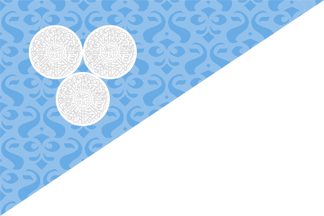 1370 (Empire of Timur Leng)
1370 (Empire of Timur Leng)
 1220 (Empire of Genghis Khan)
1220 (Empire of Genghis Khan)
 1077 (Persia - Khwarezm Empire)
1077 (Persia - Khwarezm Empire)
 1045 (Persia - Seljukid dynasty)
1045 (Persia - Seljukid dynasty)
 1030-1187
(Persia -
Ghaznavid dynasty - new flag)
1030-1187
(Persia -
Ghaznavid dynasty - new flag)
 977 (Persia - Ghaznavid dynasty)
977 (Persia - Ghaznavid dynasty)
 colonial
750 (Abbassid Califate)
colonial
750 (Abbassid Califate)
 colonial
660 (Umayad Califate)
colonial
660 (Umayad Califate)
 colonial
650 (Arab conquest - Rashidun Califate)
colonial
650 (Arab conquest - Rashidun Califate)
 225 (Persia - Sassanid Empire)
225 (Persia - Sassanid Empire)
 247
BC (Persia - Parthian Empire)
247
BC (Persia - Parthian Empire)
 312
BC (Seleucid Empire)
312
BC (Seleucid Empire)
 334 BC (Empire of Alexander The
Great) (Macedonian emblem known as Sun Of
Virgina - no flag is known to have been used)
334 BC (Empire of Alexander The
Great) (Macedonian emblem known as Sun Of
Virgina - no flag is known to have been used)
 560 BC (Persia - Achemenid Empire)
560 BC (Persia - Achemenid Empire)
MARKO's project :
 SOVIETIC UZBEKISTAN
SOVIETIC UZBEKISTAN INDEPENDENT UZBEKISTAN
INDEPENDENT UZBEKISTAN MARKO's PROJECT
MARKO's PROJECT
The emblem adopted by UZBEKISTAN when it became
independent in 1991 is VERY PAINFUL as it's a copy-paste of
the comunist / sovietic emblem. Please get rid of the
wreaths of cotton & wheat. +over U L get a UNIC
emblem !!!!

Very good emblem when got rid of
its comunist / sovietic insignia of shit. - The comunist /
sovietic emblem looked 100% SHIT. Independent UZBEKISTAN's
emblem look 50% comunist / sovietic of SHIT. MARKO's project look
100% UZBEK.
MARKO's heraldry notes :





KAZAKSTAN beautiful
emblem TÜRKMENISTAN beautiful emblem
(MARKO's project) OZBEKISTAN beautiful
emblem (MARKO's project) KIRGHIZIA seal
(not so bad as the sovietic stuf is
discret) TAJIKISTAN atrocious
post-sovietic


 It loox 100% EXACTLY
like MAGYARORSZAG bolsho-comunist OF SHIT, ATROCIOUS
COMUNIST SHIT.
It loox 100% EXACTLY
like MAGYARORSZAG bolsho-comunist OF SHIT, ATROCIOUS
COMUNIST SHIT.
TAJIKISTAN sovietic
shit
TAJIKISTAN is THE ONLY emblem that can
NOT be rearranged, due to the fact that, if you drop both
wreaths (cotton & wheat), it remains nothing at all in
matter of surrounding shape !!!!!

TAJIKISTAN MARKO's project inspired by
the VERY GOOD former emblem of 1992-1993


 emblem of the region
SOLTÜSTIK KAZAKSTAN (I absolutely LOVE that so typical
"kokoshka" dezign !!!!)
emblem of the region
SOLTÜSTIK KAZAKSTAN (I absolutely LOVE that so typical
"kokoshka" dezign !!!!)
KIRGHIZIA sovietic shit
KIRGHIZIA seal
- On the VERY CONTRARY, I think KIRGHIZIA should adopt
ANOTHER emblem, shaped as its FORMER SOVIETIC emblem, as the
"kokoshka" shape is extraordinary.
NOTE :
 Pierre C. Lux-Wurm
wrote : "bordure jaune d'or". Maybe the orange was used to
create the visual impression of a gold fringe. Who knows ????
Pierre C. Lux-Wurm
wrote : "bordure jaune d'or". Maybe the orange was used to
create the visual impression of a gold fringe. Who knows ????
The border of that Bukhara Emirate from 1785 is usualy ORANGE. Yet I still
have a doubt after readin "bordure jaune d'or". It reminds me
the masturbation about AZAD KASHMIR, PAKISTAN. Just look here
> markodehaeck.free.fr/PK.htm
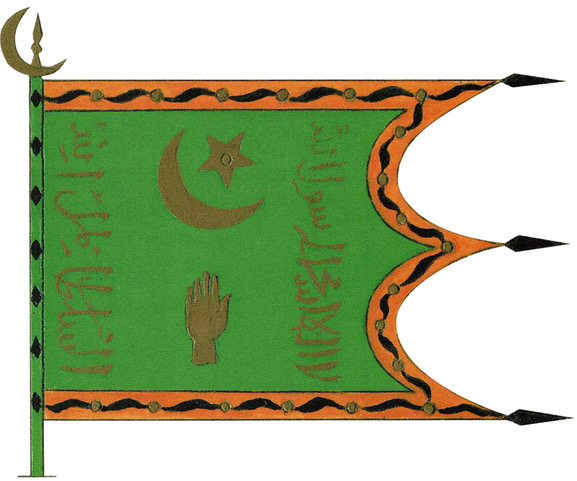 scan of the flag in
Lux-Wurm that shows gold ink and orange border - The writing
nearest the hoist is the name of the Emir, whilst in the fly it
is the Shahada.
scan of the flag in
Lux-Wurm that shows gold ink and orange border - The writing
nearest the hoist is the name of the Emir, whilst in the fly it
is the Shahada.
The flag is said to be more accurately termed as a
standard of the ruler, rather than a national flag.
SOME
ODD STUF :
 Notice the upper band is
sometimes not light blue (even in RIO 2016).
Quite odd, aint it !???
Notice the upper band is
sometimes not light blue (even in RIO 2016).
Quite odd, aint it !???

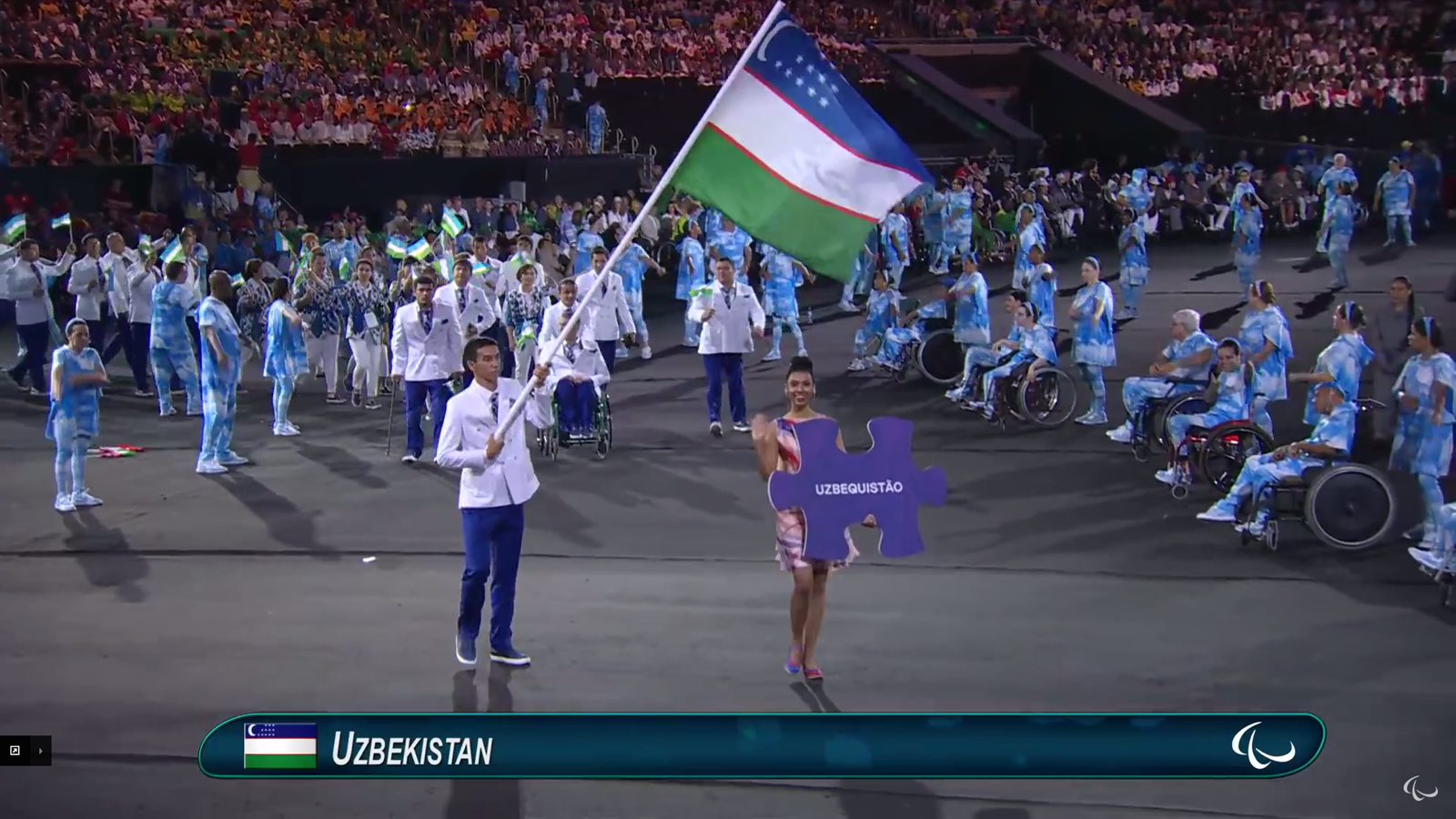
BUKHARA
 1925 (incorporated into UZBEKISTAN)
1925 (incorporated into UZBEKISTAN)
 1924 (BNSR turned into Bukharan
Socialist Soviet Republic / BSSR)
1924 (BNSR turned into Bukharan
Socialist Soviet Republic / BSSR)
 1923 (BNSR - new flag)
1923 (BNSR - new flag)
 1921 (BSNR turned into Bukharan People's Soviet
Republic / BNSR)
1921 (BSNR turned into Bukharan People's Soviet
Republic / BNSR)
 (variant)
(variant)
 1920 (BSNR - new flag)
1920 (BSNR - new flag)
 1919 (Bukharan Soviet People's Republic / BSNR)
1919 (Bukharan Soviet People's Republic / BSNR)
 1917 (Bukhara Emirate - new flag)
1917 (Bukhara Emirate - new flag)
 1785 (Bukhara Emirate)
1785 (Bukhara Emirate)
 1505 (Khanate of Bukhara - war flag)
1505 (Khanate of Bukhara - war flag)
NOTE :
 My drawing of the
Bukhara Emirate new flag from 1917 is made after this photo
taken in 2006 in the Bukhara History and Local Lore Museum. It
says that the flag is green, in spite of it looking blue-black
in the photo.
My drawing of the
Bukhara Emirate new flag from 1917 is made after this photo
taken in 2006 in the Bukhara History and Local Lore Museum. It
says that the flag is green, in spite of it looking blue-black
in the photo.
The flag is partly folded
and appears to have a partial swallow-tail indentation.
The flag seems to be more likely
termed as a royal standard rather than a national flag....
thou it's a lil bit odd this flag appears in the middle of
Emir Alim Khan's reign, that existed from 1911 till 1920. So
why a flag change in 1917 ????
KHOREZM / KHIVA
 1925 (incorporated into UZBEKISTAN)
1925 (incorporated into UZBEKISTAN)
 1924 ("Proletarians of all
countries, unite !" written in Cyrilik Russian alfabet
- XCCP written completely Хорезмская
Социалистическая Советская Республика)
1924 ("Proletarians of all
countries, unite !" written in Cyrilik Russian alfabet
- XCCP written completely Хорезмская
Социалистическая Советская Республика)
 1923 ("Proletarians of all
countries, unite !" written in Arabic alfabet - KPSR
turned into Khorezm Socialist Soviet Republic,
itself abridged XCCP in Russian)
1923 ("Proletarians of all
countries, unite !" written in Arabic alfabet - KPSR
turned into Khorezm Socialist Soviet Republic,
itself abridged XCCP in Russian)
 1922 (KPSR - new flag)
(Notice the stuf often drawn as a hoe is a stem of djugare &
the stuf often drawn as a spear is a spade.)
1922 (KPSR - new flag)
(Notice the stuf often drawn as a hoe is a stem of djugare &
the stuf often drawn as a spear is a spade.)
 April 1920 (KPSR - new flag)
April 1920 (KPSR - new flag)
 January 1920 (Khorezm People's Soviet Republic -
KPSR)
January 1920 (Khorezm People's Soviet Republic -
KPSR)
 1917 (Khanate of
Khiva - new flag)
(idiot ratio 10:25 insted of a simple 1:2)
1917 (Khanate of
Khiva - new flag)
(idiot ratio 10:25 insted of a simple 1:2)
 1873 (Khanate of Khiva - new flag)
1873 (Khanate of Khiva - new flag)
 1804
(Khanate of Khiva - gradualy known to foreigners and also localy
as Khanate of Khiva but oficial name remains Khorezm)
1804
(Khanate of Khiva - gradualy known to foreigners and also localy
as Khanate of Khiva but oficial name remains Khorezm)
 1770 (De facto ruled by tribal leaders
whose title was "Inak")
1770 (De facto ruled by tribal leaders
whose title was "Inak")
 1750 (Zand dynasty - Persia)
1750 (Zand dynasty - Persia)
 1736 (Afsharid dynasty / Nader
Shah - Persia)
1736 (Afsharid dynasty / Nader
Shah - Persia)
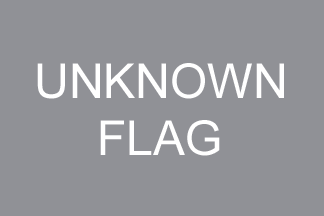 1511 (Khanate of Khorezm)
1511 (Khanate of Khorezm)
NOTE #1 :
The oficial 1922 emblem on a 1922 stamp. I tried my best for the
1922 flag !!!!

NOTE #2 :
a foto from the museum of Khiva
 LINK HERE >
imgur.com/1TU51Y3
LINK HERE >
imgur.com/1TU51Y3
NOTE #3 :
the spearhead before the flag, visible on the foto just above,
loox 100% like a Persian Alam
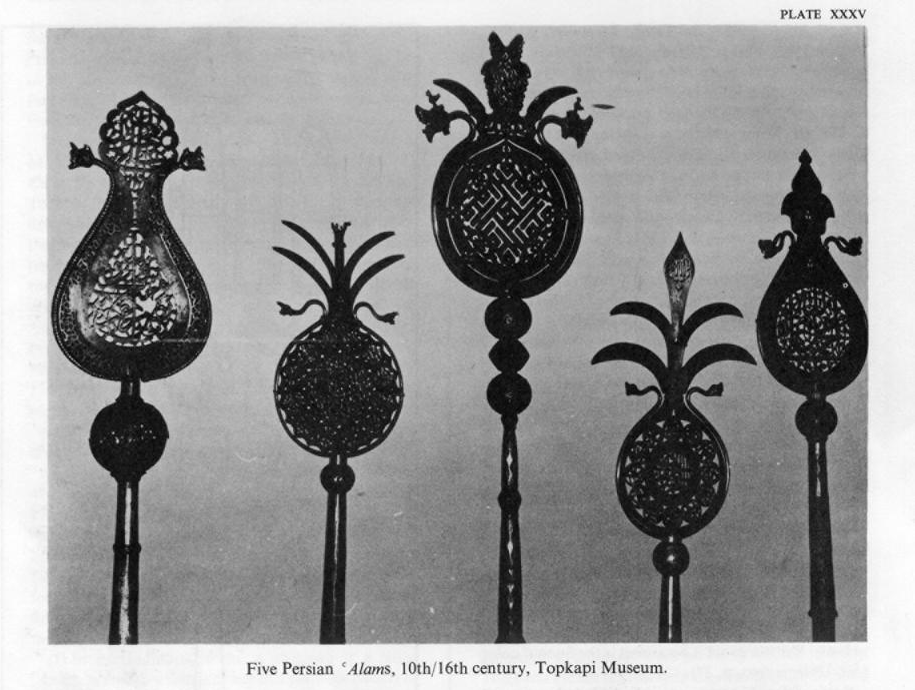
KOKAND
 1925 (incorporated into UZBEKISTAN)
1925 (incorporated into UZBEKISTAN)
 1921 (part of Turkestan)
1921 (part of Turkestan)
 1919 (part of Turkestan)
1919 (part of Turkestan)
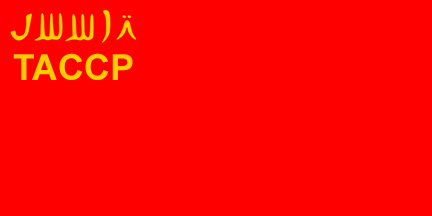 1918 (part of Turkestan)
1918 (part of Turkestan)
 1917 (Autonomous Government of Kokand)
1917 (Autonomous Government of Kokand)
 colonial 1914
colonial 1914
 (detail)
(detail)
 (enhanced)
(enhanced)
 colonial 1883
colonial 1883
 colonial 1876 (Russia)
colonial 1876 (Russia)
 1841 (anexed by Bukhara Emirate)
1841 (anexed by Bukhara Emirate)
 1757 (under suzerainty of China - Qing dynasty)
1757 (under suzerainty of China - Qing dynasty)
 1700
(rule consolidated by Beks of Fergana - Khanate of Fergana
/ capital established at Kokand in 1732 gives name to state -
Khanate of Kokand)
1700
(rule consolidated by Beks of Fergana - Khanate of Fergana
/ capital established at Kokand in 1732 gives name to state -
Khanate of Kokand)
 1505
(Khanate of Bukhara - war flag) (De facto
ruled by tribal leaders whose title was "Bek" from 1626)
1505
(Khanate of Bukhara - war flag) (De facto
ruled by tribal leaders whose title was "Bek" from 1626)
+ 1 BONUS FLAG :

KARAKALPAK (autonomous
republic) (sovietic ratio of shit)
+ 2 EXTRA BONUS
FLAGZ & 2 EXTRA MAPS :
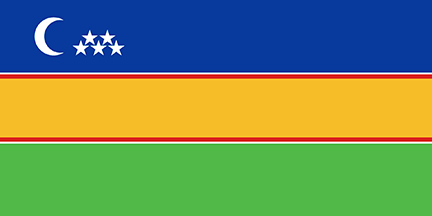 right shades
???? - Just exactly like
UZBEKISTAN, for KARAKALPAKSTAN, I dont understand ABSOLUTELY
NOTHIN about the shades of the colorz....
right shades
???? - Just exactly like
UZBEKISTAN, for KARAKALPAKSTAN, I dont understand ABSOLUTELY
NOTHIN about the shades of the colorz....
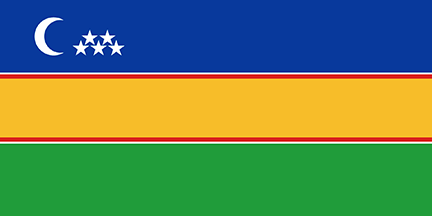 right shades
???? - KARAKALPAKSTAN REPUBLIC is an autonomous republic included
within UZBEKISTAN - TOO CLOSE to Uzbekistan's flag !!!! That's why I had an idea....
right shades
???? - KARAKALPAKSTAN REPUBLIC is an autonomous republic included
within UZBEKISTAN - TOO CLOSE to Uzbekistan's flag !!!! That's why I had an idea....
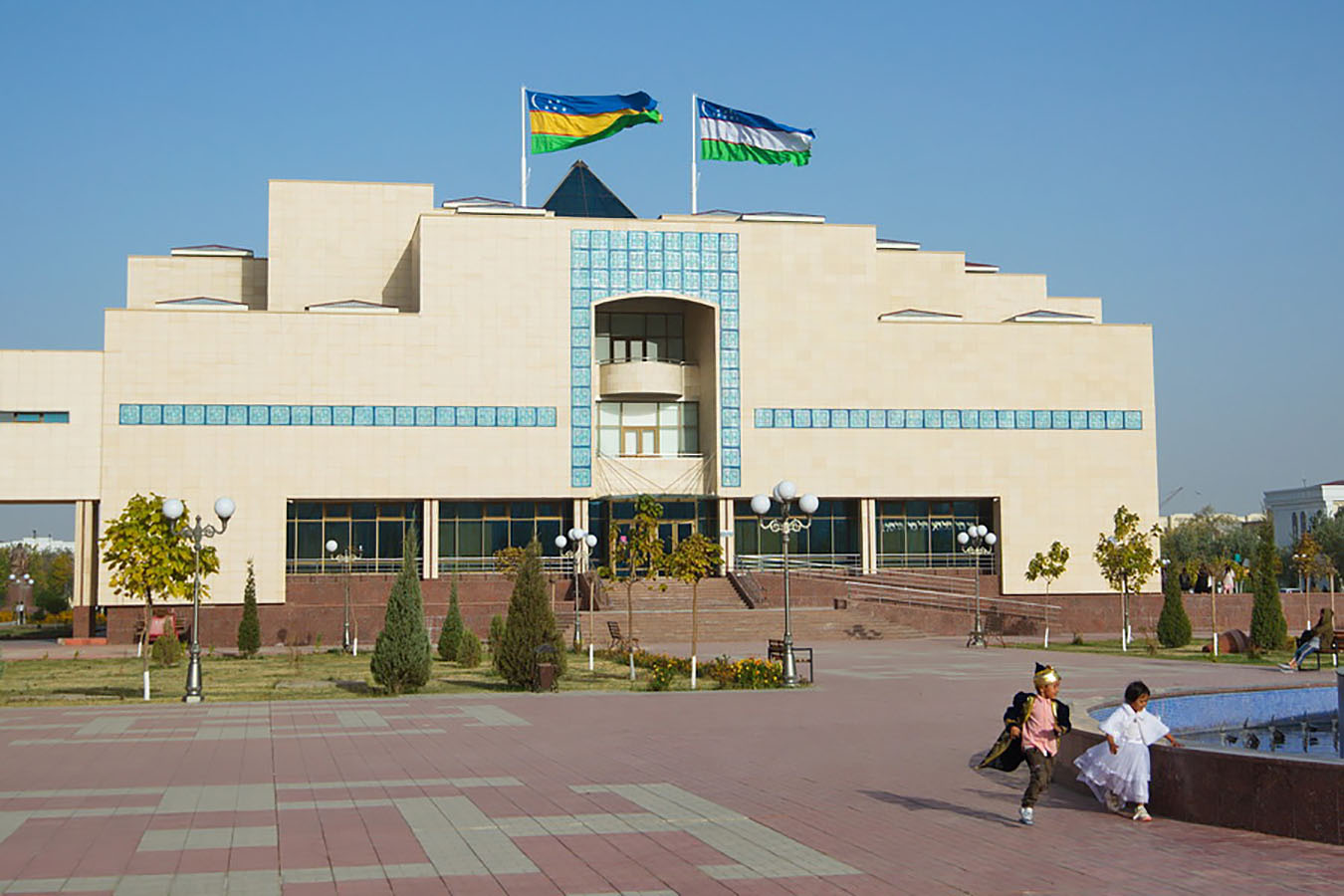 IGOR SAVITSKY
MUSEUM OF ARTS, NUKUS
IGOR SAVITSKY
MUSEUM OF ARTS, NUKUS
 KARAKALPAKSTAN REPUBLIC (& people) MARKO's
project - Green turned into blak for 3 reasons : Khwarezm flag of
1077, Khiva Khanate flag of 1917, the name KARA KALPAK.
KARAKALPAKSTAN REPUBLIC (& people) MARKO's
project - Green turned into blak for 3 reasons : Khwarezm flag of
1077, Khiva Khanate flag of 1917, the name KARA KALPAK.
 I
have made 2 versions (the first with a flag ratio 3:5 and the
second with a flag ratio 2:3) in order to get rid of the sovietic flag
ratio 1:2 - Notice the same goluboy as the Kazak flag.
I
have made 2 versions (the first with a flag ratio 3:5 and the
second with a flag ratio 2:3) in order to get rid of the sovietic flag
ratio 1:2 - Notice the same goluboy as the Kazak flag.


The
Karakalpak
People is ethnic / linguistic / cultural closer to the Kazak
People than to the Uzbek People and maybe should join
Kazakstan..........
The
second map includin Karakalpak gives a + coherent southern
frontiere to Kazakstan.
The
name "Karakalpak" means Black (Kara) Beanies (Kalpak).
 administrative
map of KARAKALPAK
administrative
map of KARAKALPAK
 map
+/- 2020
map
+/- 2020
 MARKO's project
for KHWAREZM not to be fucked up anymore
MARKO's project
for KHWAREZM not to be fucked up anymore
 MARKO's project for both enhanced
KHWAREZM & NAVOÏ (K&N)
MARKO's project for both enhanced
KHWAREZM & NAVOÏ (K&N)
to get rid of all thoze
stalino-bolshevik-mental-dizease frontieres of shit and as
theres NO KARAKALPAK People in the K&N area......
+ 1 EXTRA BONUS FLAG :
 BASMACHI MOVEMENT (1921-1924) (uprising
both against Russian Imperial and Soviet rule by the peoples of
Turkestan)
BASMACHI MOVEMENT (1921-1924) (uprising
both against Russian Imperial and Soviet rule by the peoples of
Turkestan)
This flag was formed by the
combination of the three colors used by Turkic empires in the past
- red, white and orange. It was composed of nine alternating
stripes, five red and four white, with an orange rectangle located
next to the hoist of the flag between the two upper and two lower
stripes. This field bore a white star and crescent. The sky-blue
border around the edges of the flag signifies the pre-Islamic
period of Turkestan and the descendance of these nationalities
from the Turkic-Mongol race.
The nine red and white stripes
represent the historical regional states of Turkestan :
Kichi-Gjuz, Ortha-Djuz, Ulu-Djuz, the Sultanates of Kashgar and
Berat, the Khivan, Kokand and Turkmen khanates and the Bukharian
emirate. These stripes also represent the nationalities of
Turkestan : Uzbeks, Kazakhs, Uyghurs, Tajiks, Turkmenes, Kirghiz,
Kara-Kalpaks, Pamirians (in Badakshan) and four other small Turkic
tribes living in this country.
The red color was used in the
ancient flags of the Kirgiz, Kipchaks, and Odjuz Turksand. The red
stripes recall the plain red of the pre-1884 Merv Khanate, and the
red flags of all Muslim Turkic peoples, while the orange appeared
in the flags of the Uyghurs and the pre-islamic Turkestani
sultans. The white color symbolises the traditions of the flags of
Genghis Khan, the Golden Horde and the Il-Khana.
Heres 3 examples of historical
orange flagz :
 Great Hun Empire (204 BC - 216 AD)
Great Hun Empire (204 BC - 216 AD)
 Uyghur Khaganate (744-840)
Uyghur Khaganate (744-840)
 Kara-Khanid Khanate (840-1212)
Kara-Khanid Khanate (840-1212)
The ratio seems to be 4:7 acordin
to the Italian vexillolog Roberto BRESCHI here. But Roberto does
not bring any proof of a ratio 4:7. So I guess we can draw this
flag with a "normal" ratio 2:3.
However Roberto BRESCHI says this
flag is "Islamic Republic of Turkestan, Panturania".
#1 : "Islamic
Republic of Turkestan" does NOT refer to this flag as it's the
flag of the BASMACHI MOVEMENT. Indeed : "Islamic Republic of
Turkestan" shall refer to Turkish Islamic Republic of East
Turkestan (now part of CHINA) and its flag was the one below :
 Turkish
Islamic Republic of East Turkestan
(1933-1934) (self-proclaimed but unrecognized State)
Turkish
Islamic Republic of East Turkestan
(1933-1934) (self-proclaimed but unrecognized State)
#2 :
"Panturania" is not a place : it is a political ideology that is
called Turanism or Pan-Turanianism. In the 19° century it
proclaimed the need for close cooperation or alliances between
culturally, linguistically or ethnically related peoples of
Inner-Asian origin. The concept was narrowed to "Pan-Turkic" and
the concept was promoted by the Ottoman Young Turks, which gained
power in the Ottoman Empire in 1908. The Pan-Turkic concept
glorified the Turkish ethnic identity and sought to link up
Ottoman Turks with the other Turks of the world.
 I redrew the flag 2:3 as WikiMERDIA did here. But, as usual,
WikiMERDIA is just shit as they forgot the thin light blue border
!!!! I think BASMACHI MOVEMENT flag shall be 2:3 just as it loox
about the flag below :
I redrew the flag 2:3 as WikiMERDIA did here. But, as usual,
WikiMERDIA is just shit as they forgot the thin light blue border
!!!! I think BASMACHI MOVEMENT flag shall be 2:3 just as it loox
about the flag below :
 BASMACHI
REBELLION in Turkestan (1918-1921) (flag of
Kurshermat who was a leader of the Basmachi Rebellion from 1918
till 1921)
BASMACHI
REBELLION in Turkestan (1918-1921) (flag of
Kurshermat who was a leader of the Basmachi Rebellion from 1918
till 1921)
After the
February Revolution of 1917 in Turkestan there was political
rivalry between nationalist reformers, ethnic Russian socialists
who formed various soviets which included both bolsheviks &
mensheviks, and conservative islamists. By February 1918 the
Bolshevik Red Army had gained control of Turkestan killing about
25000 people in the conflict and destroying the local economy . An
insurgency of mostly muslim rural peasants and cotton-growing
landowners developed to oppose foreign control (id est Russian and
communist) and was pejoratively described by the communists as
"Basmaschi", which was a Turkic word for "bandit". A force of up
to 25000 peasant-soldiers was recruited and began attacking
Russian settlements and the Red Army. There was no central
command, the fighters were organised locally in units of several
thousand and usually commanded by a local land-owner or religious
leader, though there were some overall political leaders.
There is little known about the flags of the Basmachi during the
period. However one banner was captured by the Red Army in 1921 -
it is now in the State Museum of History of Uzbekistan in
Tashkent. The banner is that of the Basmachi unit led by a local
landowner named Kurshermat. The red banner is rectangular fringed
red cloth 95 cm wide and 115 cm long. The field bears the
inscription embroidered in white Arabic script : There is no god
but Allah and Muhammad is the prophet of Allah - from Allah the
only religion is Islam. In the upper hoist there is a crescent and
star in white. Note that the image is of the reverse of the banner
(the crescent and star is at the top hoist). It is not known if
this was a "one-off" or the pattern for banners for all the
Basmachi units. The source for the flag is an article in The Flag
Bulletin issue 95 (July 1982) The
Captured Banner of Kurshermat - article by the Russian
vexillolog V. A. SOKOLOV.
Many thanx to Ralph
KELLY for his HUGE work & his precious help in findin
so many info for me. Spasibo takoye
Viktor LOMANTSOV.

administrative
map of OZBEKISTAN with its
stalino-bolshevik-mental-dizease frontieres of
shit....
 1991 (independence) (sovietic ratio of
shit)
1991 (independence) (sovietic ratio of
shit)
 naval ensign
naval ensign


 capital : TASHKENT
capital : TASHKENT fascist 1955 (hammer & sickle redezigned)
fascist 1955 (hammer & sickle redezigned) fascist
1952 (new flag)
fascist
1952 (new flag) fascist
1941
(both names written with
Cyrilik letters)
fascist
1941
(both names written with
Cyrilik letters) fascist
1939 (the name Ozbekistan is turned into
Ozbekstan without the "i" to get closer to the Uzbek
spelling of the name)
fascist
1939 (the name Ozbekistan is turned into
Ozbekstan without the "i" to get closer to the Uzbek
spelling of the name) fascist
1937 (full
names written)
fascist
1937 (full
names written) fascist
1935 (new
spelling of the word "republic" in Uzbek - "Ç"
replaced by "R")
fascist
1935 (new
spelling of the word "republic" in Uzbek - "Ç"
replaced by "R") fascist 1934
(new spelling of the word "socialist"
in Uzbek - "b" replaced by "S")
fascist 1934
(new spelling of the word "socialist"
in Uzbek - "b" replaced by "S") fascist
1931 (line #1 = Uz SSR in Uzbek
with Latin letters, line #2 = Uz SSR in Russian, line
#3 dropped as Tajikistan SSR created apart)
fascist
1931 (line #1 = Uz SSR in Uzbek
with Latin letters, line #2 = Uz SSR in Russian, line
#3 dropped as Tajikistan SSR created apart) fascist
1929 (line #1 = Uz SSR in Uzbek with
Latin letters, line #2 = Uz SSR in Russian, line #3 = Uz SSR in Tajik with Latin
letters)
fascist
1929 (line #1 = Uz SSR in Uzbek with
Latin letters, line #2 = Uz SSR in Russian, line #3 = Uz SSR in Tajik with Latin
letters) fascist
1927 (line #1 = Uz SSR in Uzbek with Arab letters,
line #2 = Uz SSR in
Russian, line #3 = Uz SSR in Tajik with Arab
letters)
fascist
1927 (line #1 = Uz SSR in Uzbek with Arab letters,
line #2 = Uz SSR in
Russian, line #3 = Uz SSR in Tajik with Arab
letters) fascist
1924 (Y3 CCP or Ўзбекистон Совет Социалистик
Республикаси - Uzbek Soviet Socialist Republic - USSR)
(flag changed only in 1925)
fascist
1924 (Y3 CCP or Ўзбекистон Совет Социалистик
Республикаси - Uzbek Soviet Socialist Republic - USSR)
(flag changed only in 1925) fascist
1921 (Turkestan Soviet Socialist Republic / TSSR -
new flag)
fascist
1921 (Turkestan Soviet Socialist Republic / TSSR -
new flag)  fascist
1919 (TCCP or TSSR / Туркестанская Советская
Социалистическая Республика - Turkestan Soviet Socialist
Republic)
fascist
1919 (TCCP or TSSR / Туркестанская Советская
Социалистическая Республика - Turkestan Soviet Socialist
Republic) fascist
1918 (TACCP or Туркестанская Автономная Советская
Социалистическая Республика - Turkestan Autonomous Soviet
Socialist Republic)
fascist
1918 (TACCP or Туркестанская Автономная Советская
Социалистическая Республика - Turkestan Autonomous Soviet
Socialist Republic) 1917 (Autonomous Government of Kokand)
1917 (Autonomous Government of Kokand) colonial
1914
colonial
1914
 (detail)
(detail)
 (enhanced)
(enhanced)  colonial
1883
colonial
1883 colonial
1868 (Russia)
colonial
1868 (Russia) 1785
(Bukhara Emirate)
1785
(Bukhara Emirate)  1505
(Khanate of Bukhara - war flag)
1505
(Khanate of Bukhara - war flag) 1405 (Timurid dynasty after Timur Leng died in
1405)
1405 (Timurid dynasty after Timur Leng died in
1405) 1370 (Empire of Timur Leng)
1370 (Empire of Timur Leng) 1220 (Empire of Genghis Khan)
1220 (Empire of Genghis Khan) 1077 (Persia - Khwarezm Empire)
1077 (Persia - Khwarezm Empire)  1045 (Persia - Seljukid dynasty)
1045 (Persia - Seljukid dynasty) 1030-1187
(Persia -
Ghaznavid dynasty - new flag)
1030-1187
(Persia -
Ghaznavid dynasty - new flag) 977 (Persia - Ghaznavid dynasty)
977 (Persia - Ghaznavid dynasty) colonial
750 (Abbassid Califate)
colonial
750 (Abbassid Califate) colonial
660 (Umayad Califate)
colonial
660 (Umayad Califate) colonial
650 (Arab conquest - Rashidun Califate)
colonial
650 (Arab conquest - Rashidun Califate) 225 (Persia - Sassanid Empire)
225 (Persia - Sassanid Empire) 247
BC (Persia - Parthian Empire)
247
BC (Persia - Parthian Empire)  312
BC (Seleucid Empire)
312
BC (Seleucid Empire) 334 BC (Empire of Alexander The
Great) (Macedonian emblem known as Sun Of
Virgina - no flag is known to have been used)
334 BC (Empire of Alexander The
Great) (Macedonian emblem known as Sun Of
Virgina - no flag is known to have been used) 560 BC (Persia - Achemenid Empire)
560 BC (Persia - Achemenid Empire)  SOVIETIC UZBEKISTAN
SOVIETIC UZBEKISTAN MARKO's PROJECT
MARKO's PROJECT






 It loox 100% EXACTLY
like MAGYARORSZAG bolsho-comunist OF SHIT, ATROCIOUS
COMUNIST SHIT.
It loox 100% EXACTLY
like MAGYARORSZAG bolsho-comunist OF SHIT, ATROCIOUS
COMUNIST SHIT.

 emblem of the region
SOLTÜSTIK KAZAKSTAN (I absolutely LOVE that so typical
"kokoshka" dezign !!!!)
emblem of the region
SOLTÜSTIK KAZAKSTAN (I absolutely LOVE that so typical
"kokoshka" dezign !!!!)



 1925 (incorporated into UZBEKISTAN)
1925 (incorporated into UZBEKISTAN) 1924 (BNSR turned into Bukharan
Socialist Soviet Republic / BSSR)
1924 (BNSR turned into Bukharan
Socialist Soviet Republic / BSSR) 1923 (BNSR - new flag)
1923 (BNSR - new flag) 1921 (BSNR turned into Bukharan People's Soviet
Republic / BNSR)
1921 (BSNR turned into Bukharan People's Soviet
Republic / BNSR)
 (variant)
(variant) 1920 (BSNR - new flag)
1920 (BSNR - new flag) 1919 (Bukharan Soviet People's Republic / BSNR)
1919 (Bukharan Soviet People's Republic / BSNR) 1917 (Bukhara Emirate - new flag)
1917 (Bukhara Emirate - new flag)  1785 (Bukhara Emirate)
1785 (Bukhara Emirate) 1505 (Khanate of Bukhara - war flag)
1505 (Khanate of Bukhara - war flag) 
 1925 (incorporated into UZBEKISTAN)
1925 (incorporated into UZBEKISTAN)  1924 ("Proletarians of all
countries, unite !" written in Cyrilik Russian alfabet
- XCCP written completely
1924 ("Proletarians of all
countries, unite !" written in Cyrilik Russian alfabet
- XCCP written completely  1923 ("Proletarians of all
countries, unite !" written in Arabic alfabet - KPSR
turned into Khorezm Socialist Soviet Republic,
itself abridged XCCP in Russian)
1923 ("Proletarians of all
countries, unite !" written in Arabic alfabet - KPSR
turned into Khorezm Socialist Soviet Republic,
itself abridged XCCP in Russian)  1922 (KPSR - new flag)
(Notice the stuf often drawn as a hoe is a stem of djugare &
the stuf often drawn as a spear is a spade.)
1922 (KPSR - new flag)
(Notice the stuf often drawn as a hoe is a stem of djugare &
the stuf often drawn as a spear is a spade.) April 1920 (KPSR - new flag)
April 1920 (KPSR - new flag) January 1920 (Khorezm People's Soviet Republic -
KPSR)
January 1920 (Khorezm People's Soviet Republic -
KPSR) 1917 (Khanate of
Khiva - new flag)
(idiot ratio 10:25 insted of a simple 1:2)
1917 (Khanate of
Khiva - new flag)
(idiot ratio 10:25 insted of a simple 1:2) 1873 (Khanate of Khiva - new flag)
1873 (Khanate of Khiva - new flag) 1804
(Khanate of Khiva - gradualy known to foreigners and also localy
as Khanate of Khiva but oficial name remains Khorezm)
1804
(Khanate of Khiva - gradualy known to foreigners and also localy
as Khanate of Khiva but oficial name remains Khorezm)  1770 (De facto ruled by tribal leaders
whose title was "Inak")
1770 (De facto ruled by tribal leaders
whose title was "Inak")  1750 (Zand dynasty - Persia)
1750 (Zand dynasty - Persia)
 1736 (Afsharid dynasty / Nader
Shah - Persia)
1736 (Afsharid dynasty / Nader
Shah - Persia) 1511 (Khanate of Khorezm)
1511 (Khanate of Khorezm)
 LINK HERE >
LINK HERE >

 1925 (incorporated into UZBEKISTAN)
1925 (incorporated into UZBEKISTAN) 1921 (part of Turkestan)
1921 (part of Turkestan) 1919 (part of Turkestan)
1919 (part of Turkestan) 1918 (part of Turkestan)
1918 (part of Turkestan) 1917 (Autonomous Government of Kokand)
1917 (Autonomous Government of Kokand) colonial 1914
colonial 1914
 colonial 1883
colonial 1883 colonial 1876 (Russia)
colonial 1876 (Russia) 1841 (anexed by Bukhara Emirate)
1841 (anexed by Bukhara Emirate) 1757 (under suzerainty of China - Qing dynasty)
1757 (under suzerainty of China - Qing dynasty) 1700
(rule consolidated by Beks of Fergana - Khanate of Fergana
/ capital established at Kokand in 1732 gives name to state -
Khanate of Kokand)
1700
(rule consolidated by Beks of Fergana - Khanate of Fergana
/ capital established at Kokand in 1732 gives name to state -
Khanate of Kokand) 1505
(Khanate of Bukhara - war flag) (De facto
ruled by tribal leaders whose title was "Bek" from 1626)
1505
(Khanate of Bukhara - war flag) (De facto
ruled by tribal leaders whose title was "Bek" from 1626)
 right shades
???? - Just exactly like
UZBEKISTAN, for KARAKALPAKSTAN, I dont understand ABSOLUTELY
NOTHIN about the shades of the colorz....
right shades
???? - Just exactly like
UZBEKISTAN, for KARAKALPAKSTAN, I dont understand ABSOLUTELY
NOTHIN about the shades of the colorz.... right shades
???? -
right shades
???? -  IGOR SAVITSKY
MUSEUM OF ARTS, NUKUS
IGOR SAVITSKY
MUSEUM OF ARTS, NUKUS
 I
have made 2 versions (the first with a flag ratio 3:5 and the
second with a flag ratio 2:3) in order to
I
have made 2 versions (the first with a flag ratio 3:5 and the
second with a flag ratio 2:3) in order to 



 MARKO's project
for KHWAREZM not to be fucked up anymore
MARKO's project
for KHWAREZM not to be fucked up anymore MARKO's project for both enhanced
KHWAREZM & NAVOÏ (K&N)
MARKO's project for both enhanced
KHWAREZM & NAVOÏ (K&N) BASMACHI MOVEMENT (1921-1924) (uprising
both against Russian Imperial and Soviet rule by the peoples of
Turkestan)
BASMACHI MOVEMENT (1921-1924) (uprising
both against Russian Imperial and Soviet rule by the peoples of
Turkestan) Great Hun Empire (204 BC - 216 AD)
Great Hun Empire (204 BC - 216 AD) Uyghur Khaganate (744-840)
Uyghur Khaganate (744-840) Kara-Khanid Khanate (840-1212)
Kara-Khanid Khanate (840-1212) Turkish
Islamic Republic of East Turkestan
(1933-1934) (self-proclaimed but unrecognized State)
Turkish
Islamic Republic of East Turkestan
(1933-1934) (self-proclaimed but unrecognized State) I redrew the flag 2:3 as WikiMERDIA did
I redrew the flag 2:3 as WikiMERDIA did  BASMACHI
REBELLION in Turkestan (1918-1921) (flag of
Kurshermat who was a leader of the Basmachi Rebellion from 1918
till 1921)
BASMACHI
REBELLION in Turkestan (1918-1921) (flag of
Kurshermat who was a leader of the Basmachi Rebellion from 1918
till 1921)